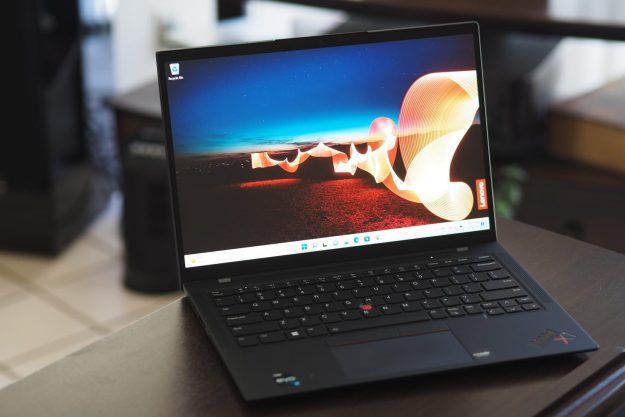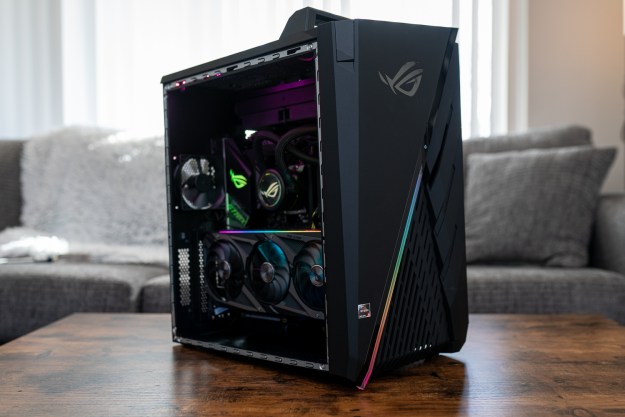
“A top-tier gaming PC held back by some frustrating design choices.”
- Stays cool under loud
- Vertical GPU looks great
- Two front USB-C ports
- Hot-swappable SSD drives
- Standard sized components
- No horizontal GPU option
- A little loud
- Upgrades are more frustrating than they should be
If you want one of the best gaming PCs in 2021, building your own isn’t an option. Prebuilts used to be overpriced, underpowered options compared to building your own PC, but thanks to the GPU shortage, they are downright good deals. And that’s what the Asus ROG GA35 G35DX is — a great deal for 2021.
I have some issues with it compared to boutique options from Origin and Maingear, but the ROG GA35 still has plenty of power to impress. It’s not too expensive, either, at least in the pricing crisis that’s plaguing PC components right now. If I didn’t already have a graphics card from waiting in line at Best Buy, the ROG GA35 would be near the top of my list of options.
It probably quite wouldn’t make the cut, though. Small issues like poor cable management and the lack of thumbscrews hold the GA35 back from reaching the top tier of prebuilt gaming PCs. That doesn’t mean it’s a bad choice, especially with high-end Asus hardware under the hood.
Design
Previous G-series Asus desktops used a taller, more traditional mid-tower case design, but the GA35 doesn’t. It has a stocky case design, measuring 16.5 inches long and just under 11 inches wide to accommodate a dual-chamber design. I’m a fan of dual-chamber cases, but it doesn’t feel like the GA35 uses the space effectively.
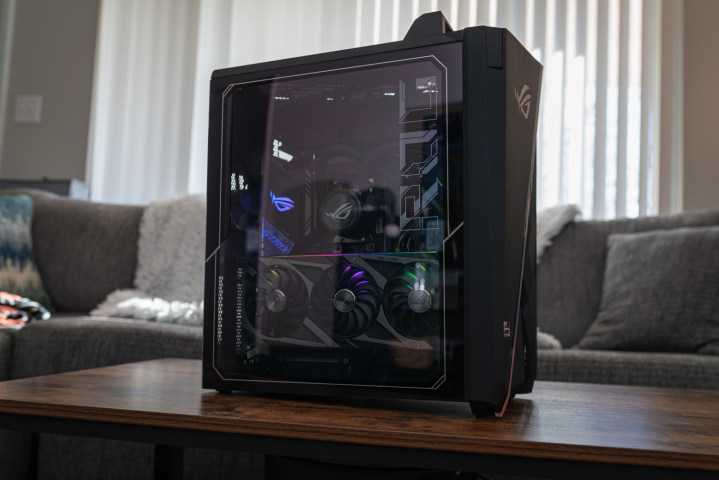
I’ll talk more about the internal build later. For now, just know that both chambers are the same size. The back portion holds the power supply and the cable mess, and the front holds all of the beautiful RGB components necessary to any modern gaming rig. Hide the ugly, show the glitter — that’s what dual-chamber cases provide.
There are some strange design choices, though. The all-in-one (AIO) liquid cooler is installed in the back chamber, exhausting air that doesn’t have an intake. It also causes the braided liquid tubes to lay awkwardly across the motherboard, which is a trend I noticed with the internal layout of the GA35.
Airflow wasn’t an issue, but it could have been better. The only included fan is a 92mm exhaust at the back of the case, and there isn’t space to mount any other fans. The machine was a little loud during my testing, but it wasn’t anything like the Lenovo Thinkstation P620. It didn’t get too hot, either, with the CPU topping out at 48 degrees Celsius after a 30-minute AIDA64 stress test.
The GA35 is a cohesive, RGB-ridden PC that looks wonderful.
That’s mainly on the back of the open case design. There are filters staggered around the angular edges of the GA35, cleverly hidden in the nooks and crannies of the case. None of them have dust filters, so you’ll have to be diligent to keep the inside clean.
The temperature surprised me given that the GA35 uses a vertical mount for the power-hungry RTX 3090. The vertical mount does wonders for the visuals, too. The GA35 is adorned with as many ROG Strix products as possible, including the RTX 3090. The result is a cohesive, RGB-ridden PC that looks wonderful when it’s lit up.
Connectivity

Asus makes some of the best gaming motherboards you can buy, so I wasn’t surprised to the GA35 kitted out with excellent connectivity. You get a pair each of USB-C and USB 3.0 ports at the front of the case, along with separate headphone and microphone inputs, putting even pricey machines like the Origin Neuron to shame.
Around the back, you have access to a further seven USB 3.2 ports, another USB-C port, Gigabit Ethernet, and the standard range of audio connections. All of those ports are great, but the two front USB-C ports make the difference for me. My personal rig, which I built with a Lian Li PC-011 Dynamic, only has a single USB-C port up front. I’m jealous I don’t have a second now, as I was able to plug in both my Samsung T5 and the Steelseries Prime Wireless into the GA35 without reaching around the back.
Storage expansion is excellent, too. The case includes two hot-swappable SSD bays at the front, as well as an extra slot for a 3.5-inch hard drive in the HDD cage. The motherboard has two M.2 expansion slots — one of which is filled from the factory — though you’ll have to wrestle with getting the GPU out to access them.
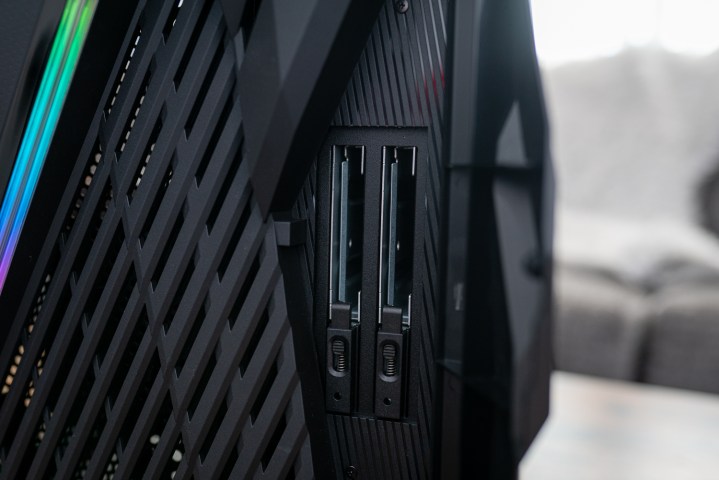
The port selection is great, rivaling the likes of boutique designs like the Falcon Northwest Talon. I like the extra storage space, too, but I would’ve liked Asus to put those efforts toward swapping other components, not adding more storage.
Specs and internals
Asus had four models of the GA35 that offer different GPU and CPU configurations. Every model comes with the same specs otherwise — 16GB of DDR4-3200 memory, a custom Asus X570 motherboard, an 80 Plus Gold power supply, and 3TB of total storage (1TB NVMe SSD and 2TB HDD).
| CPU | AMD Ryzen 9 5900X |
| GPU | Asus ROG Strix RTX 3090 |
| Motherboard | Custom Asus ROG Strix X570-F motherboard |
| Case | Custom Asus ROG case |
| Memory | 16GB unbranded DDR4-3200 |
| Storage | 1TB PCIe 3.0 NVMe SSD, 2TB HDD |
| Power supply | Delta 850W 80+ Gold |
| USB ports | Nine USB-A, three USB-C |
| Networking | 1Gbit Ethernet |
I tested the GA35DX-XB999, which comes with a Ryzen 9 5900X and RTX 3090. This machine retails for around $5,000, which is a better deal than you might think. I configured a machine identical to the GA35, and it actually came out $100 more expensive (thanks, GPU shortage). A similarly configured Origin Neuron came out $500 more expensive, though with better cable management and more RGB.
The GA35 is a good deal on the component front. My only complaint is the PCIe 3.0 NVMe SSD. Ryzen 5000 chips support PCIe 4.0, so this is just a matter of Asus cutting where it could.
I like the dual-chamber design of the GA35, but I don’t like how closed it is for upgrades.
The GA35 has some internal problems outside of the components. The cable management is sloppy, component swaps are annoying at best and impossible at worse, and the case actively fights against you when you’re trying to get inside. I like the dual-chamber design of the GA35, but I don’t like how closed it is for upgrades.
It isn’t anything like the Alienware Aurora R10. You can still swap out components because everything inside adheres to ATX standards. It’s just a hassle to get there. There are extra screws at every turn, and they’re buried. There aren’t even thumbscrews to unlatch the side panels, much less a tool-less design like the HP Omen 30L offers.
A plastic shroud covers the outside of the chassis, which is as cheap as it is frustrating. I immediately broke one of the plastic tabs holding on the front cover, and I wasn’t applying enough pressure to get off. There are long plastic tubes in the middle of each piece of the shell to keep you out, and that’s all they’re good for.
Cable management is sloppy, but you don’t see it right away. It’s like shining a flashlight on a dusty desk in a dark room, revealing all of the messy bits that you’ve been unaware of. Opening up the case, I quickly noticed ketchup-and-mustard cables going to the graphics card, an extra CPU power connector just hanging off the side, and several small wires for RGB and fan connections pressed into crevasses around the motherboard. All of the chunky cables are routed through a single channel, too, revealing a small bird’s nest of cables up front that only grows in the back chamber.

The vertical GPU mount is a welcome addition, but it’s your only option. The RTX 3090 just barely fits when laid flat, and the GA35 doesn’t have a bracket for this type of configuration. It only has two vertical brackets, locking you out of upgrading to a triple-slot GPU in the future.
For specs, the GA35 is as high-end as PCs come. Asus made some clear design choices to discourage users from upgrading down the line, even though the form factor allows those upgrades.
Productivity performance
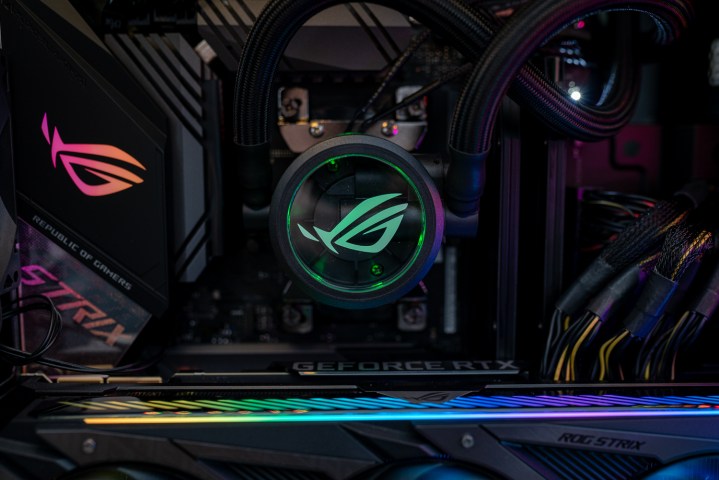
The Asus GA35 is a performant machine, but the Ryzen 9 5900X is starting to show some age compared to the best and brightest from Intel. It’s still leagues ahead of 10th-gen and 11th-gen Intel chips, and the single-core performance is great for gaming. However, the higher core count of the Ryzen 9 5950X and the hybrid architecture of the Core i9-12900K give them an edge over the Ryzen 9 5900X.
| Asus ROG GA35 | Custom PC (Core i9-12900K, RTX 3090) | Origin Neuron (Ryzen 9 5950X, RTX 3080 Ti) | |
| Cinebench R23 multi-core | 21,907 | 27,344 | 25,166 |
| Cinebench R23 single-core | 1,501 | 1,989 | 1,587 |
| Geekbench 5 multi-core | 12,695 | 18,282 | 15,872 |
| Geekbench 5 single-core | 1,692 | 1,962 | 1,682 |
| PugetBench for Premiere Pro | 1,115 | 1,283 | 1,088 |
| Blender (Average in seconds, lower is better) | 53 | N/A | 53 |
| Handbrake (Seconds, lower is better) | 58 | 47 | 50 |
You can clearly see that in my results. For single-core performance, the machine matches the Ryzen 9 5950X in the Origin Neuron in Cinebench and Geekbench. Unsurprisingly, the Ryzen 9 5950X performed well above the 5900X in the multi-core tests, with the four extra cores bringing as much as a 15% increase.
Outside of pure processor benchmarks, the GA35 shows more power. It was able to achieve a higher score than the Origin Neuron in PugetBench for Premiere Pro, showing the small acceleration provided by the RTX 3090, and it matched the Neuron in Blender. I tested Blender with CUDA rendering, so this is my most interesting result. The RTX 3090 showed no benefit over the RTX 3080 Ti.
Intel’s Core i9-12900K throws off this delicate comparison between the Ryzen 9 5950X and 5900X. It’s faster across the board, sometimes by as much as 25%. This isn’t true of older Intel chips, though. Step back to the Core i9-11900K, and the GA35 can wipe the floor.
The GA35 performs about where I expected it to. It’s great, but I wouldn’t recommend the configuration with the RTX 3090. It provides a minor uplift in some cases, and in others, it offers no benefit at all. That’s all the more true when it comes to gaming performance, which is probably why you’re interested in the GA35.
Gaming performance
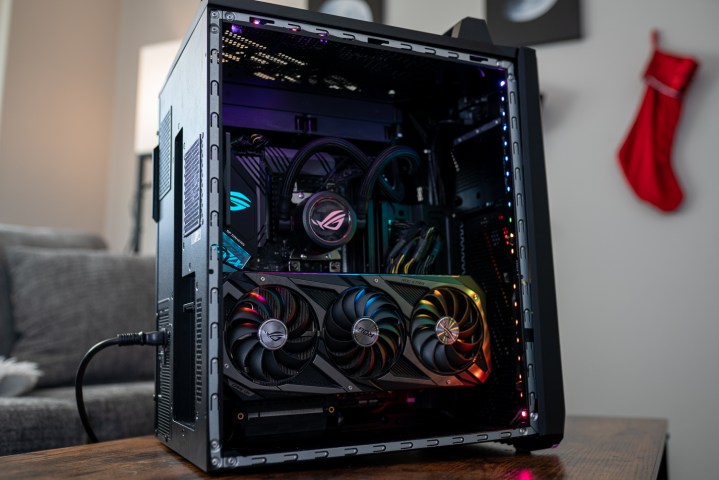
The GA35 is built for 4K — and it better be with an RTX 3090 under the hood. I ran a suite of benchmarks across resolutions, but I only included my results at 4K with the highest possible graphics preset. This should bind performance to the GPU, removing the CPU from the equation. But my results show some big differences.
| Asus ROG GA35 | Custom PC (Core i9-12900K, RTX 3090) | Origin Neuron (Ryzen 9 5950X, RTX 3080 Ti) | |
| Forza Horizon 4 | 147 fps | 160 fps | N/A |
| Red Dead Redemption 2 | 73 fps | 79 fps | 72 fps |
| Assassin’s Creed Valhalla | 69 fps | 66 fps | 55 fps |
| 3DMark Time Spy | 17,356 | 19,511 | 17,937 |
| Fortnite | 78 fps | N/A | 89 fps |
In Forza Horizon 4 and Red Dead Redemption 2, the GA35 underperformed compared to my custom-built rig with an RTX 3090. The processors are different, but they shouldn’t be impacting performance much. Even the aging Core i9-10900K put up better results in these two games when paired with RTX 3090.
RAM is the problem. The GA35 only comes with 16GB of RAM, which is a strange configuration for such a high-end system. Beyond capacity, Asus doesn’t use branded RAM modules. A representative from the company told me that the modules use memory from Samsung, Micron, and Hynix. And if you know anything about Ryzen processors, you know how big of a difference these dies can make.
I wasn’t able to verify the dies used for the modules inside my review unit. I used Corsair memory in the other two machines, though, which use Samsung B-die modules (known to perform best with Ryzen chips). By going with 16GB of DDR4-3200, Asus chose the lowest reasonable option — and that shows in my results. DDR4-3600 modules would solve the problem, but otherwise, you’re leaving some minor performance on the table.
The RTX 3090 actually shows a big benefit in Assassin’s Creed Valhalla.
3DMark Time Spy shows how well the machine performs relative to the Origin Neuron. My custom-built rig was able to achieve a higher score, but that’s on the back of the Core i9-12900K.
Assassin’s Creed Valhalla is interesting, too. This game still has problems with Intel’s 12th-gen platform, explaining the lower results I saw with my custom PC. The RTX 3090 actually shows a big benefit here, pushing the GA35 above the Origin Neuron. In most other cases, the extra power of the RTX 3090 provided no benefit.
The GA35 is a super-fast gaming PC. There’s no doubt about that. There are a few small problems, though, mostly centered around the system memory. In most cases, the differences aren’t any more than a few frames. But they’re present, and you should keep them in mind if you plan on dropping $5,000.
Warranty and support
Asus offers a standard one-year warranty for the GA35. Finding that out was a chore, though. The warranty information isn’t printed on the warranty card, and you can’t find it on Asus’ website. Instead, it’s listed on a sticker on the back of the machine, noted only as “12M” with no context. What’s frustrating is that Asus includes a copy of this sticker on the warranty card — just without the warranty information.
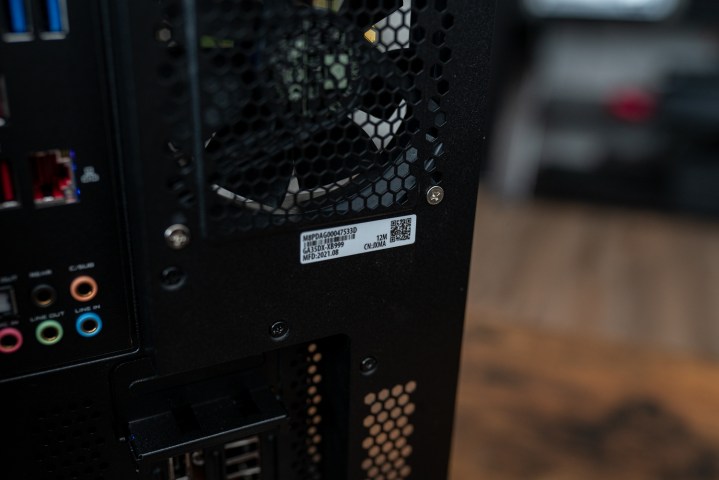
You can purchase up to three years of coverage plus accidental damage protection. The standard warranty only covers defects and issues with workmanship. One year is par for the course with desktops. That said, Asus could make accessing the warranty easier instead of splitting the information across three locations.
Along with the warranty information, you’ll find a product support card. Asus offers 24/7 phone support, as well as live chat and email. For the second two, the support pamphlet points you to a website that doesn’t work. I had to navigate through Asus’ support page to find the right spot.
Like the machine itself, Asus isn’t doing anything wrong with its warranty or support. There are just extra unnecessary steps that can make the process frustrating.
Our take
The Asus GA35 is one hell of a gaming PC. It’s stacked with top-of-the-line hardware that delivers in gaming and productivity without getting too hot (though, the fan is loud). It uses a standard form factor, too, so upgrades are possible even if they aren’t always practical.
It’s just not everything it could be. Thumbscrews, black power supply cables, and closer attention to upgrading would push it to the top of our list of the best desktop computers. I recommend the GA35, but you should know about its quirks before dropping $5,000.
Are there any alternatives?
Yes. The Origin Neuron and Maingear Vybe are the most direct competition, and the Vybe costs about $1,000 less. HP’s Omen 30L is also a solid alternative thanks to its high-end hardware and tool-less case design.
The Alienware Aurora R14 and Falcon Northwest Talon are high-end gaming options, too, though they are both slightly different than the GA35. The Aurora R14 is more restrictive when it comes to upgrades, while the Northwest Talon uses all off-the-shelf parts and costs a little more.
How long will it last?
The GA35 comes packed with powerful hardware, so it should last several years with what’s inside. You can always upgrade down the line, but the case doesn’t make upgrades as easy as they could be.
Should you buy it?
Yes, as long as you’ve considered the other options. The Maingear Vybe and Origin Neuron are both top-tier gaming PCs, and the GA35 is just a small step below them. It still performs well, but the Maingear and Origin options are a little easier when it comes time to upgrade.
Editors' Recommendations
- No, The Last of Us PC requirements aren’t changing
- Meta Quest Pro vs. Quest 2: a clear choice for VR gaming
- The best gaming PCs for 2023: Dell, Origin, Lenovo, and more
- The best desktop computers for 2023: Dell, HP, Apple, and more
- The best tablets in 2023: top 9 picks you should buy



